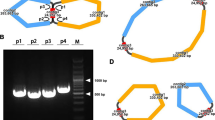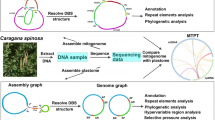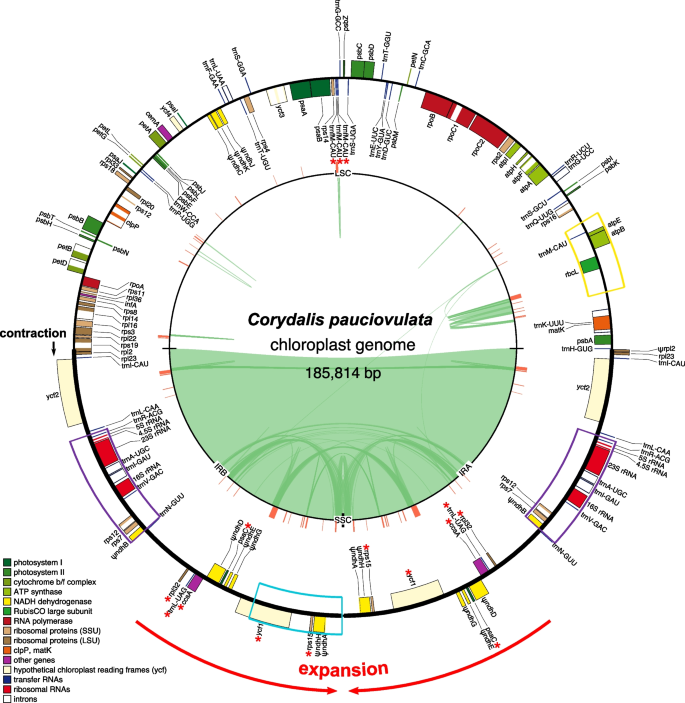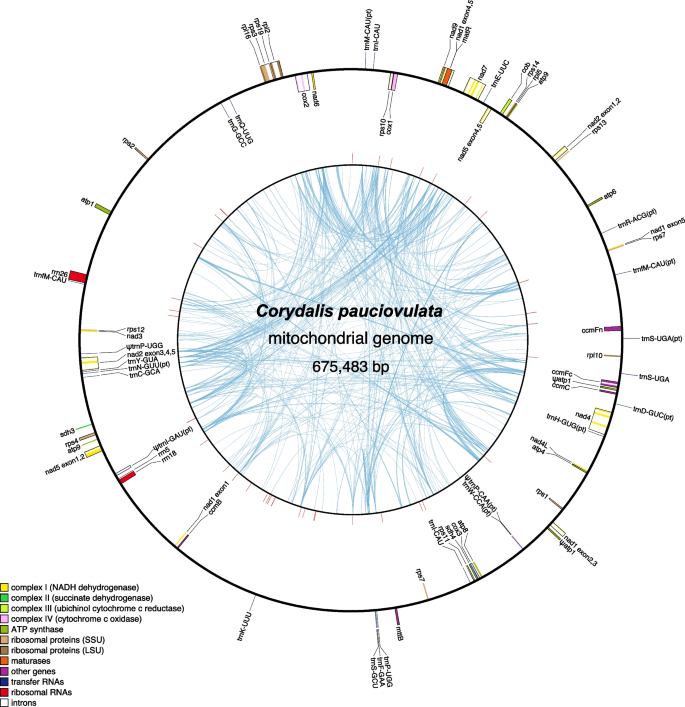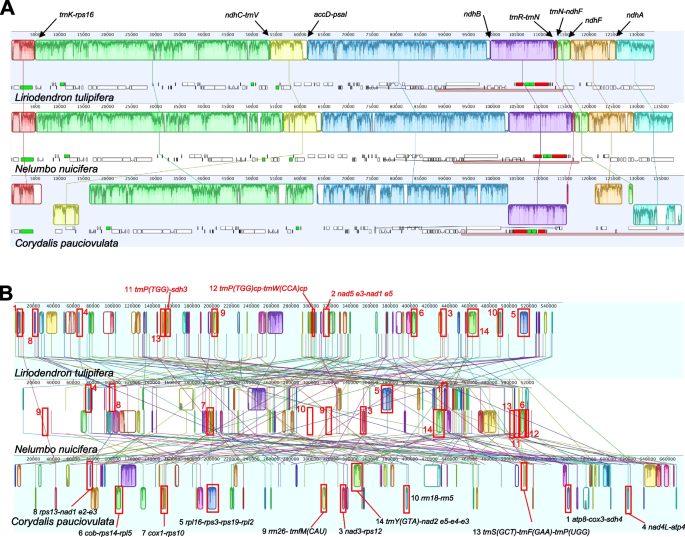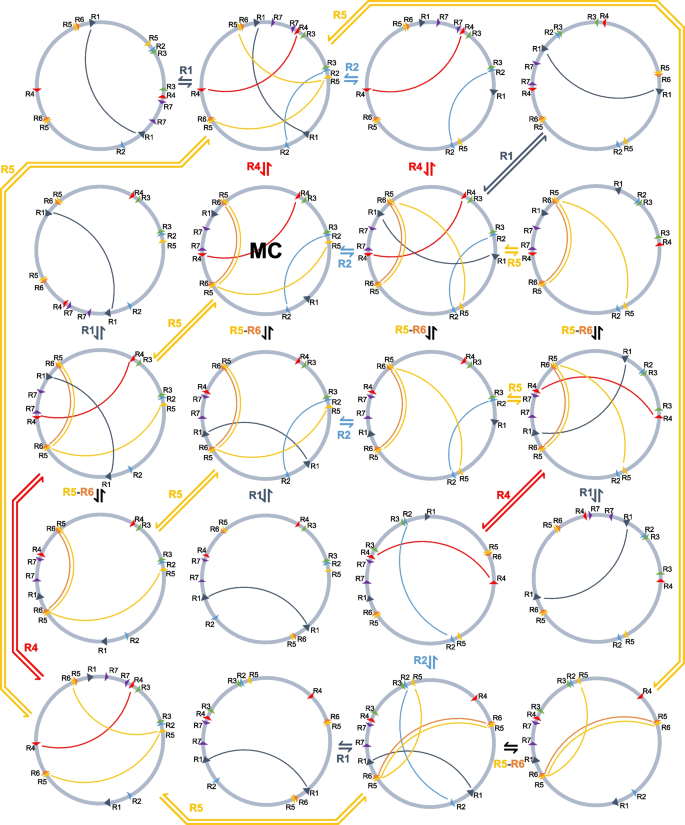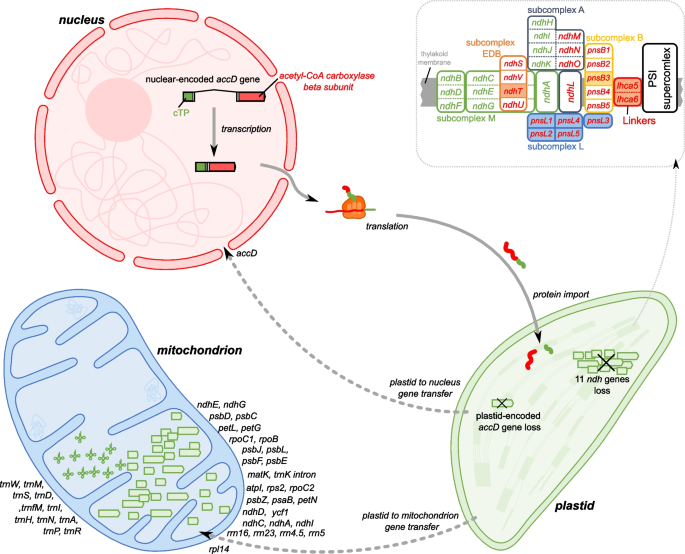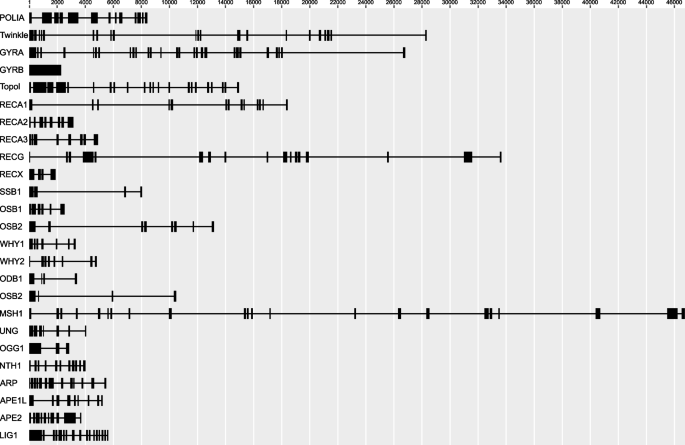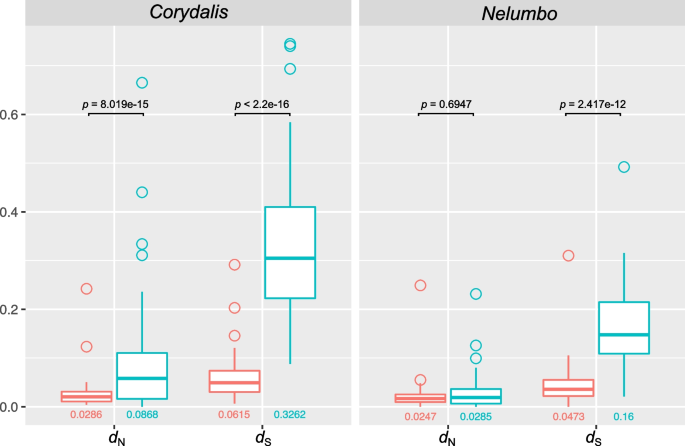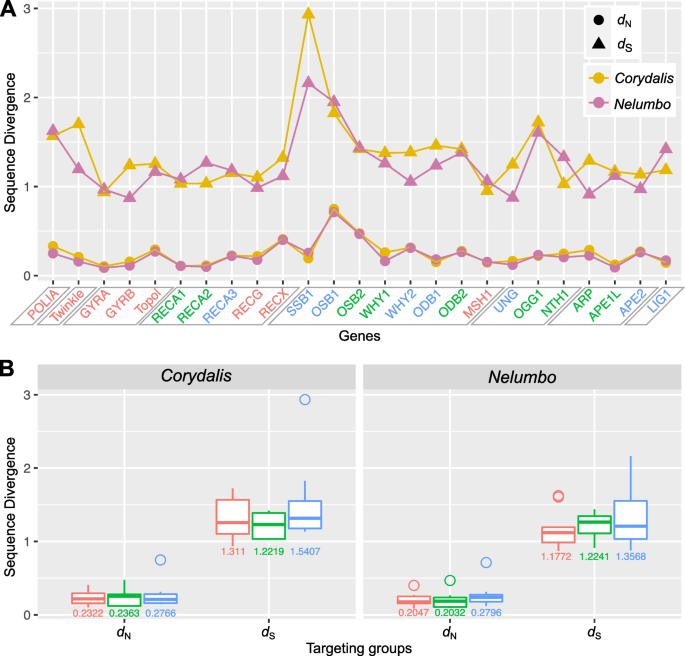Abstract
Background
Corydalis DC., the largest genus in the family Papaveraceae, comprises > 465 species. Complete plastid genomes (plastomes) of Corydalis show evolutionary changes, including syntenic arrangements, gene losses and duplications, and IR boundary shifts. However, little is known about the evolution of the mitochondrial genome (mitogenome) in Corydalis. Both the organelle genomes and transcriptomes are needed to better understand the relationships between the patterns of evolution in mitochondrial and plastid genomes.
Results
We obtained complete plastid and mitochondrial genomes from Corydalis pauciovulata using a hybrid assembly of Illumina and Oxford Nanopore Technologies reads to assess the evolutionary parallels between the organelle genomes. The mitogenome and plastome of C. pauciovulata had sizes of 675,483 bp and 185,814 bp, respectively. Three ancestral gene clusters were missing from the mitogenome, and expanded IR (46,060 bp) and miniaturized SSC (202 bp) regions were identified in the plastome. The mitogenome and plastome of C. pauciovulata contained 41 and 67 protein-coding genes, respectively; the loss of genes was a plastid-specific event. We also generated a draft genome and transcriptome for C. pauciovulata. A combination of genomic and transcriptomic data supported the functional replacement of acetyl-CoA carboxylase subunit β (accD) by intracellular transfer to the nucleus in C. pauciovulata. In contrast, our analyses suggested a concurrent loss of the NADH-plastoquinone oxidoreductase (ndh) complex in both the nuclear and plastid genomes. Finally, we performed genomic and transcriptomic analyses to characterize DNA replication, recombination, and repair (DNA-RRR) genes in C. pauciovulata as well as the transcriptomes of Liriodendron tulipifera and Nelumbo nuicifera. We obtained 25 DNA-RRR genes and identified their structure in C. pauciovulata. Pairwise comparisons of nonsynonymous (dN) and synonymous (dS) substitution rates revealed that several DNA-RRR genes in C. pauciovulata have higher dN and dS values than those in N. nuicifera.
Conclusions
The C. pauciovulata genomic data generated here provide a valuable resource for understanding the evolution of Corydalis organelle genomes. The first mitogenome of Papaveraceae provides an example that can be explored by other researchers sequencing the mitogenomes of related plants. Our results also provide fundamental information about DNA-RRR genes in Corydalis and their related rate variation, which elucidates the relationships between DNA-RRR genes and organelle genome stability.
Similar content being viewed by others
Background
Mitochondria and plastids originate from alphaproteobacterial and cyanobacterial endosymbionts, respectively [1, 2]. The genomes of both are highly reduced relative to the ancestral genome because substantial numbers of genes were lost, and many essential genes were transferred into the nuclear genome of a host cell over evolutionary time [3]. In angiosperms, the mitochondrial and plastid genomes (mitogenomes and plastomes) are critical in respiration and photosynthesis, encoding only 41 and 79 proteins, respectively [4, 5]. Thus, coordination between nuclear-encoded organelle-targeted and organelle-encoded proteins is essential for their function [6]. This process involves the import of nuclear-encoded organelle-targeted proteins, which contributes to organelle genome stability [7]; DNA replication, recombination, and repair (RRR) system [8]; posttranscriptional regulation, and translation initiation [9]. Many nuclear-encoded organelle-targeted proteins are dual-targeted to mitochondria and plastids [10]. Dysfunction of DNA-RRR genes, such as RECA and MSH1, has been suggested to be a mechanism for rate acceleration of angiosperm organelle genomes [11, 12]. These genes also regulate recombination activity in mitogenomes [13, 14]. Researchers examined the relationship between dysfunction in DNA-RRR systems and plastome complexity in Geraniaceae and revealed a significant correlation between substitution rates and three DNA-RRR genes (GYRA, WHY1, and UVRB/C) [15]. Thus, a comprehensive understanding of organelle genome evolution in plants requires a combination of organelle genomics and transcriptomics approaches.
The mitogenome and plastome of angiosperms vary in size, structure, and gene content, although the organelle genomes exhibit parallel evolutionary relics. For example, angiosperm mitogenomes range from 65.7 kb in Viscum scurruloideum [16] to 11.3 Mb in Silene conica [12], containing variable protein-coding genes ranging from 19 in V. scurruloideum [16] to 41 in Liriodendron tulipifera [17]. They exhibit multipartite organization, mapping as circular, linear, or branched molecules due to active recombination associated with repeats [18]. In contrast, angiosperm plastomes generally exhibit a circular quadripartite structure with large single-copy (LSC) and small single-copy (SSC) regions separated by two copies of an inverted repeat (IR) region, varying from 11.3 kb to 242.5 kb in size with 5–79 protein-coding genes [5, 19]. However, the plastomes of some lineages of angiosperms exhibit structural changes, including IR loss and genome rearrangements [20]. In both genomes, several organelle genes have been successfully transferred to the nucleus through direct intracellular gene transfer (IGT) or substitution by a nuclear homolog [21]. In addition to IGT to the nucleus, intercompartmental transfers between organellar counterparts have been observed (mitochondrial DNA of plastid origin, MIPTs; plastid DNA of mitochondrial origin, PLMTs) [22]. MIPTs are a common feature of the mitogenome in angiosperms, while PLMTs are rare.
The genus Corydalis DC. consists of annual or perennial herbaceous plants and belongs to Papaveraceae Juss. It comprises approximately 465 species distributed throughout the Northern Hemisphere and tropical eastern Africa [23]. The plastomes of 72 Corydalis species have been sequenced (the NCBI database, accessed on May 24, 2023), representing only 15.5%. The sequenced Corydalis plastomes ranged in size from 149.9 kb in C. mucronifera (BK063233) to 218.8 kb in C. hendersonii (OP747311) with a quadripartite organization. The variation in plastome sizes within the genus is due to IR expansions, ranging from 22.7 kb to 54.9 kb. The Corydalis plastomes also exhibit divergent structural evolution, including multiple inversions and gene losses [24,25,26,27]. In particular, the losses of acetyl-CoA carboxylase subunit β (accD), ATP-dependent Clp protease proteolytic subunit gene (clpP), or all 11 subunits of NADH-plastoquinone oxidoreductase (ndh) are lineage-specific events within the genus [27, 28].
Corydalis organelle genomes can provide excellent examples for studying the evolution of genome architecture, gene losses, mutation rates, and cytonuclear interactions. However, no complete mitogenome has been assembled and analyzed for the genus Corydalis, even at the level of the family Papaveraceae. We also have limited knowledge about DNA-RRR proteins in the Corydalis nuclear genome. In this study, we sequenced, assembled, and analyzed the complete sequences of the plastid and mitochondrial genomes of C. pauciovulata Ohwi and generated a draft nuclear genome and transcriptome. Corydalis pauciovulata Ohwi is an annual or biennial herb native to moist regions near streams and mountain valleys in Korea and Japan [29]. Our purpose of this study was to 1) explore the evolutionary characteristics of the C. pauciovulata plastid and mitochondrial genomes, 2) determine the nuclear-encoded DNA-RRR proteins, 3) identify the evolutionary fate of the lost genes in the organelle genomes, and 4) understand the driving factors of the dynamic genomic features of C. pauciovulata organelle genomes. For do that, we compared them to those of Nelumbo nucifera (since none of the Corydalis has a published mitogenome), as well as L. tulipifera as an outgroup, for which both organelle genomes and the transcriptome are available, to better understand the evolution of gene content, structure, and substitution rates.
Results
Organelle genome assemblies and genome organization
The newly sequenced plastid and mitochondrial genomes of C. pauciovulata were assembled into circular molecules with lengths of 185,814 bp and 675,483 bp, respectively (Table 1 and Figs. 1 and 2). Depth of coverage analyses revealed that the organelle genomes were deeply (PE/MP/ONT; plastome: 3,092 × /1,932 × /280 × , mitogenome: 170 × /155 × /26 ×) covered (Figure S1), supporting the accuracy of the assemblies.
The Corydalis pauciovulata plastome. Thick lines on the genome map indicate the inverted repeats (IRa and IRb: 46,060 bp), which separate the genome into small (SSC: 202 bp) and large (LSC: 92,155) single-copy regions. Genes on the inside and outside of the map are transcribed in clockwise and counterclockwise directions, respectively. Asterisks indicate genes transferred from single-copy regions to the IR, and ψ denotes a pseudogene. The red lines on the inner circle indicate tandem repeats. The black and red arrows on the outside of the map indicate contraction and expansion events, respectively. The colored boxes on the map correspond to the locally collinear blocks inferred by Mauve (see Fig. 3). The green lines within the inner circle indicate the positions of the pairs of repeats, with crossed connecting lines denoting reverse repeats
The Corydalis pauciovulata mitogenome. Genes on the inside and outside of the map are transcribed in clockwise and counterclockwise directions, respectively. The red lines on the inner circle indicate tandem repeats, and ψ denotes a pseudogene. The blue lines within the inner circle indicate the positions of the pairs of repeats, with crossed connecting lines denoting reverse repeats
The C. pauciovulata plastome had a general quadripartite structure; however, it contained expanded IR (46,060 bp) and miniaturized SSC (202 bp) regions (Fig. 1). An analysis of genome rearrangements with L. tulipifera and N. nucifera suggested that the C. pauciovulata plastome has experienced three inversions with eight breakpoints: trnK-rps16, ndhC-trnV, accD-psaI, ndhB, trnR-trnN, trnN-ndhF, ndhF, and ndhA (Fig. 3A). The first inversion (yellow box) with the rbcL-atpB-atpE-trnM region was relocated (Figs. 1 and 3A). Compared to the published L. spectabilis plastome, which is from a related genus in the same subfamily, the second inversion (purple box) involving a pair of breakpoints (ndhB and trnR-trnN) in the IR region suggests a lineage-specific event (Fig. 1 and Figure S2). The third inversion (blue box) with the ycf1-rps15-ndhH-ndhA region was the result of the expansion of the IRB (Figs. 1 and 3A).
Structural alignments of the organelle genome arrangements in Corydalis pauciovulata. Blocks drawn below the horizontal line indicate sequences found in an inverted orientation. A The colored blocks represent collinear sequence blocks shared by all plastomes. Individual genes and strandedness are represented below the Liriodendron genome block. Only one copy of the inverted repeat (IR) is shown for each plastome, and the pink box below each plastome block indicates its IR. B The colored blocks represent collinear sequence blocks shared by all mitogenomes. The red boxes indicate the conserved gene clusters
The C. pauciovulata mitogenome showed high levels of structural divergence in comparison to the L. tulipifera and N. nucifera mitogenomes (Fig. 3B). However, 11 conserved gene clusters were present in the C. pauciovulata mitogenome among the 14 ancestral gene clusters. Three ancestral gene clusters were missing in Corydalis: nad5 exon 3-nad1 exon 5, sdh3-trnP-UGG, and trnP-UGG(cp)-trnW-CCA(cp) (Fig. 3B). In the N. nucifera conserved gene clusters, only one gene cluster was missing (nad5 exon 3-nad1 exon 5; Fig. 3B). The C. pauciovulata mitogenome contained 459 repeat pairs, including three large (> 1 kb), 77 intermediate (100–1000 bp), and 379 small (< 100 bp) repeats (Table 1 and Fig. 2). Among these repeats, seven repeat pairs (R1 to R7) were identified as potentially recombinationally active based on a thorough analysis of corrected long reads and other contigs (Figure S3). These contigs displayed conflicts with the master circle and spanned predicted recombination boundaries, providing evidence to support the determination of their recombination activity. Assuming recombination across each IR (excluding R3 and R7), 19 additional genomic conformations could be predicted (Fig. 4), all containing the same genomic information.
Mitogenome rearrangements in Corydalis pauciovulata. Alternative genomic conformations based on five repeat pairs (R1, R2, R4, R5, and R6). MC: master circle corresponding to the mitogenome in Fig. 2
Gene content in organelle genomes
The C. pauciovulata plastome contains 67 proteins, 29 tRNAs, and four rRNAs (Table 1 and Table S1). The functions of all 11 NADH-plastoquinone oxidoreductases (ndh) in the plastome were lost due to frameshift mutations (ndhJ, ndhK, and ndhG), premature stop codons (ndhC, ndhD, ndhE, and ndhH), degradation (ndhA and ndhB), or complete loss (ndhI and ndhF). In addition to the functional loss of the 11 ndh genes, the accD and trnV-UAC genes were also absent from the C. pauciovulata plastome. Multiple genes were duplicated, including sequences from the rpl32, trnL-UGA, ccsA, ψndhD, psaC, ψndhE, ψndhG, ycf1, rps15, ψndhH, and ψndhA genes, due to IR boundary shifts (Fig. 1). Triplication of trnfM-CAU was observed in the C. pauciovulata plastome (Fig. 1). The plastome of C. pauciovulata contained 99 repeat pairs, covering 7.53% of the genome (Table 1 and Fig. 1).
The C. pauciovulata mitogenome contained a full set of 41 protein-coding genes, 12 tRNAs, and three rRNAs (Table 1). Twelve plastid-derived tRNAs were identified, and two of those tRNAs were pseudogenes (Table 1 and Fig. 2). Two copies of rps7, trnP-UGG, and trnI-CAU were identified in the C. pauciovulata mitogenome, but one copy of trnP-UGG appeared to be a pseudogene (Fig. 2). Thirty-six MIPTs were identified in the C. pauciovulata mitogenome, ranging from 64 to 6,500 bp and covering 4.21% of the genome (Table S2). PREP-Mt predicted 738 putative C-to-U RNA editing sites to 41 C. pauciovulata mitochondrial protein-coding genes, more than in N. nucifera (715 sites) but fewer than in L. tulipifera (784 sites) (Table S3). The available transcriptome data for 21 mitochondrial genes revealed 357 sites, and of the 328 sites predicted by PREP-Mt for these genes, 299 (91%) were edited (Table S4). Nine hundred thirteen ORFs (≥ 150 bp in length) were identified in intergenic regions of the C. pauciovulata mitogenome. CD-search identified several ORFs harboring a partial or intact sequence homologous to RNase H (Ty1/Copia and Ty3/Gypsy), integrase, reverse transcriptase, mitovirus RNA-dependent RNA polymerase, DNA polymerase type B, and endonuclease/exonuclease/phosphatase families (Table S5). Twelve ORFs (≥ 150 bp in length) were identified that contained small fragments (> 30 bp) of one or two mitochondrial genes (e.g., atp1, rps19, rpl2, rpl5, ccmFc, rps7, cob, nad5, sdh3, and sdh4) (Table S6). Seven of these ORFs (orf457a/b, orf244, orf234, orf146, orf56, and orf54) were predicted to encode one or three transmembrane helices (Table S6). Among them, orf457a/b was immediately downstream from a repeat (R1) that overlapped with the atp1 gene; the first 701 bp of orfs and atp1 were identical. Multiple transcripts had a sequence identical to that of the ORFs (Table S6 and Figure S4). The orf146 that contained a fragment of rpl5 was also associated with repeats (R5-R6) and was upstream of rps2 and orf244 (Figure S4).
Evolutionary fate of organelle genes
To identify potential organelle-to-nucleus functional transfers (including an intermediate stage), we assembled a de novo transcriptome of C. pauciovulata. The completeness of the gene sets was assessed using BUSCO with the eudicot database of 2,236 conserved genes: 89.9% had complete gene coverage, 2.3% were fragmented, and only 7.8% were missing (Figure S5). All 79 plastid and 41 mitochondrial protein-coding genes were used to query the C. pauciovulata transcriptome. We found a nuclear-encoded accD-like ORF with 88.8% nucleotide sequence identity to the Lamprocapnos spectabilis plastid accD gene. TargetP predicted the first 84 amino acids of this ORF to be a cTP (chloroplast = 0.975). PCR and Sanger sequencing identified the nuclear-encoded plastid-targeted ACCD, and the nucleotide sequence alignments of both copies confirmed the presence of an intron (Fig. 5 and Figure S6). Using all 11 plastid ndh gene sequences from the L. spectabilis plastome as BLAST queries, we found no ndh-like gene sequences in the C. pauciovulata transcriptome. To address potential parallel loss of the plastid-encoded ndh genes and nuclear-encoded NDH-related genes in C. pauciovulata, we queried the amino acid sequences of the nuclear-encoded NDH-related protein complexes (Table S7) with the translated C. pauciovulata transcriptome. Among the 20 nuclear NDH-related genes, we found only the nuclear-encoded ndhT from subcomplex EDB, pnsB3 from subcomplex B, all subcomplex L genes (psnL1-5), and two linkers (lhca5 and lhca6) (Fig. 5).
Schematic diagram of the organelle gene transfer to the nucleus and the NDH-PSI supercomplex. The colored blocks represent collinear sequence blocks shared by all plastomes. Blocks drawn below the horizontal line indicate sequences found in an inverted orientation. Individual genes and strandedness are represented below the Euptelea genome block. Only one copy of the inverted repeat (IR) is shown for each plastome, and the pink box below each plastome block indicates its IR
Substitution of the duplicated nuclear ACCase, RPL20, RPL23, and RPS16 gene sequences for the plastids was not detected in the C. pauciovulata transcriptome; one copy of a cytosolic homolog of eukaryotic (ACCase) and mitochondrial (RPS16) origin was identified; and two copies of a cytosolic homolog of eukaryotic (RPL23) and mitochondrial (RPL20) origin were identified, but no transit peptides were predicted (Figure S7).
Identification and characterization of nuclear DNA-RRR genes
To identify C. pauciovulata DNA-RRR genes, we queried the amino acid sequences of the 32 selected DNA-RRR genes from A. thaliana, which were classified into nine categories (Table S8), with the translated C. pauciovulata transcriptome. A total of 25 DNA-RRR transcripts were identified in the transcriptome data (Table S8). We failed to find seven DNA-RRR genes, POLIB, GYRBM, SSB2, OSB3, OSB 4, WHY3, or NTH2. The predicted ORF sizes of the DNA-RRR genes ranged from 612 bp in ODB1 to 3,618 bp in Topol. We assembled a draft nuclear genome to determine the structure of DNA-RRR genes from C. pauciovulata. The frequency of 21-mers in the Illumina data was calculated using Jellyfish followed by GenomeScope (Figure S8). The proportion of homozygosity in C. pauciovulata was evaluated to be 99.2%, and the genome size was estimated to be 236.3 Mb (Figure S8). The hybrid genome assembly (PE, MP, and ONT reads) generated a draft nuclear genome of C. pauciovulata containing 3,821 contigs with a total length of 203.3 Mb. The completeness of the draft nuclear genome was also assessed using BUSCO with the eudicot database: 90.9% had complete gene coverage, 3.2% were fragmented, and only 5.9% were missing (Figure S8). The 25 DNA-RRR CDSs of C. pauciovulata were used as queries in “BLASTN” against the draft de novo nuclear genome sequence of C. pauciovulata. Available nuclear genome data for 25 genes confirmed the exon/intron patterns of the Corydalis DNA-RRR genes (Fig. 6). The number of exons in 25 genes ranged from one (GYRBC) to 27 (GYRA).
Nucleotide substitution rates
The C. pauciovulata and N. nucifera plastomes shared 67 plastid-encoded and 41 mitochondrial-encoded genes. To examine the rate variation in 108 organellar genes from C. pauciovulata, nonsynonymous (dN) and synonymous (dS) substitution rates were estimated and compared to those of N. nucifera (Figure S9). An examination of the rate variation in individual organelle genes revealed gene-specific acceleration in C. pauciovulata. The mitochondrial-encoded nad6 and the plastid-encoded atpE, clpP, petD, petG, petL, petN, rpl20, rpl23, rpl32, rps15, rps16, ycf1, ycf2, and ycf4 genes showed high levels of sequence divergence compared to the patterns of nucleotide substitutions in N. nucifera. Among them, the dN/dS values for the plastid-encoded clpP gene of C. pauciovulata were greater than one.
The estimates of nucleotide substitution rates in C. pauciovulata organelle genomes showed that plastid genes evolved significantly faster than mitochondrial genes in terms of dN and dS (C. pauciovulata, dN: 3.05-fold, dS: 5.3-fold; Fig. 7). The mitochondrial rates of C. pauciovulata were very similar to that of N. nucifera (dN: 1.16-fold, dS: 1.3-fold; Fig. 7). However, the plastid rates of C. pauciovulata were 2.11 times greater for dN and 2.04 times greater for dS than for N. nucifera (Fig. 7).
Boxplots of dN and dS values for plastid and mitochondrial genes in Corydalis pauciovulata and Nelumbo nucifera. The box represents values between quartiles, the solid lines extend to the minimum and maximum values, and the horizontal lines in the boxes show the median values. The numbers below the boxes represent the mean values
To investigate the differences between DNA-RRR genes from C. pauciovulata and N. nuicifera, substitution rates were calculated. Among the 25 nuclear-encoded genes, many C. pauciovulata genes (except RECA1, SSB1, ODB1, MSH1, OGG1, and LIG1) had slightly greater dN values than those of N. nucifera (Fig. 8A). The Twinkle, GYRB, Topol, RECG, RECX, SSB1, WHY1, WHY2, ODB1, ODB2, UNG, OGG1, ARP, APE1L, and APE2 genes from C. pauciovulata had relatively high dS values (Fig. 8A). In the C. pauciovulata comparison of dN and dS among the nuclear-encoded genes, there was no significant difference between the targeted groups (Fig. 8B).
Sequence divergence of 25 DNA replication, recombination, and repair system genes. A Nonsynonymous (dN) and synonymous (dS) divergence values for 25 individual genes are plotted for C. pauciovulata and N. nucifera. Dual-targeted, plastid-targeted, and mitochondrial-targeted genes are indicated in red, green, and blue, respectively. The DNA-RRR genes are grouped into nine categories by gray parallelograms. B Boxplots of dN and dS values for the target groups. The box represents values between quartiles, the solid lines extend to the minimum and maximum values, and the horizontal lines in the boxes show the median values. The numbers below the boxes represent the mean values. The colors corresponding to the target groups (red, dual-targeted; green, plastid-targeted; and blue, mitochondrial-targeted genes)
Discussion
In plant cells, organelle genomes require the import of nuclear-encoded organelle-targeted proteins involved in organelle genome stability, including DNA-RRR proteins [7, 8], due to endosymbiotic gene transfers [3, 30]. Modification of DNA-RRR genes is a potential cause of genome complexity [14, 30, 31]. To fully explore the correlations between the modifications of DNA-RRR genes and organelle genome complexity, it is important to produce a high-quality reference genome. However, it is challenging to assemble plastid and mitochondrial genomes that harbor repeats longer than the read length of a single-type platform for short reads [32]. Long reads generated by the ONT or PacBio platform can improve the accuracy and reliability of organelle genome structure compared with those generated by a short-read-based assembly [33, 34].
Structural variations in Corydalis pauciovulata organelle genomes
In this study, we generated high-quality assemblies of the complete plastid and mitochondrial genomes of C. pauciovulata by combining two different Illumina libraries (one paired end and one mate pair) and ONT reads. In addition, we identified 25 DNA-RRR genes from C. pauciovulata and estimated substitution rate variations in each DNA-RRR gene, and the findings provide numerous opportunities for research on organelle genome stability in the family Papaveraceae. We have shown that the C. pauciovulata plastome has undergone dynamic changes that distinguish it from most angiosperm plastomes, similar to the findings for other members of the same genus. Many Corydalis species have been identified as having rearranged plastomes, including IR expansions and gene losses [24, 27, 28]. Our plastome showed conflicting structures and sizes with those of the two published plastomes of C. pauciovulata (MK264352; 161,773 bp and NC_072192; 159,167 bp), although we cannot rule out the possibility of heterogeneous divergence in the plastomes of C. pauciovulata. For example, our plastome contained an expanded IR (46,060 bp), whereas the two published plastomes contained IRs of typical sizes (MK264352; 22,719 bp and NC_072192; 22,777 bp). Nucleotide sequence alignment of three plastomes with one IR showed that our plastome was highly similar to that of MK264352 with 98.6% identity, whereas NC_072192 was divergent, with 91.9% identity, from our plastome. These conflicting findings are difficult to interpret because of the lack of a detailed assembly method, and whether the plastome was generated using a reference or de novo approach has not been reported. Notably, the two published plastomes were generated using only short reads and different assembly tools, which may have contributed to the observed differences in plastome structure and size compared with our assembly. In plant mitogenomes, recombination with repeats results in multiple isomeric master and subgenomic circles. The C. pauciovulata mitogenome exhibits a dynamic genome structure that can be shaped by intramolecular recombination, and we demonstrated that homologous recombination is associated with five repeats, resulting in multiple isomeric master circles (Fig. 8). However, additional configurations, including subgenomic circles, may be present in the mitochondria of C. pauciovulata. Recombination activity in the mitogenome can disrupt conserved gene clusters. Comparative gene cluster analysis showed that the C. pauciovulata mitogenome may have undergone more rearrangements than the N. nuicifera mitogenome because two additional more missing gene clusters were inferred for C. pauciovulata.
Evolutionary dynamics of organelle genes
A comprehensive comparison of the nuclear and organelle genomes could help identify fates or factors that impact the evolution of mitogenomes and plastomes, including gene losses, rearrangements, and accelerated substitution rates. Although the loss of several plastid-encoded genes in Corydalis plastomes has been documented [24, 25, 27, 28], the evolutionary fates of these genes are unclear. Our results showed that the C. pauciovulata plastome lacked 12 protein-coding genes (accD and 11 ndh genes), but the mitogenome contained 41 protein-coding genes that are ancestral in angiosperms. The plastid accD gene was independently lost during angiosperm evolution, and two mechanisms of functional replacement to the nucleus have been documented for accD: 1) IGT in some Geraniaceae [35] and Trifolium [36, 37] and 2) gene substitution by a cytosolic homolog of eukaryotic origin in Brassicaceae [38, 39], Geraniaceae except for Hypseocharis [35], and Poaceae [40, 41]. Nuclear genome and transcriptome data revealed that IGT of accD from plastids to the nucleus occurred in C. pauciovulata instead of as a gene substitution, and the nuclear-encoded ACCD gene acquired an intron (Fig. 6). A previous study showed that the loss of accD occurred in the common ancestor of Corydalis [28]. Taken together, these results suggest a single ancient transfer from plastids to the nucleus in this lineage.
In contrast to accD, there is no evidence of functional replacement of the plastid-encoded ndh genes in the nucleus, although the ndh complex plays a role in electron transport during photosynthesis [42]. A suite of nuclear-encoded NDH-related protein complexes that assemble plastid-localized ndh genes is required for photosynthesis [43]. The parallel loss of NDH-related protein complexes from nuclear and plastid genomes has been reported [44, 45]. These results suggest that the plastid NDH complex has been lost in cells or that it has been functionally replaced by alternative factors. The loss of plastid ndh genes has been observed not only in parasitic [46,47,48], mycoheterotrophic [45], and carnivorous plants [49, 50] but also in multiple photoautotrophic lineages [51,52,53,54,55,56]. Multiple losses or degradations of plastid ndh genes have occurred during Corydalis plastome evolution [24, 25, 27, 28]. Although it is still unclear which factors contribute to the loss of the plastid ndh gene, possible explanations for this loss have been suggested through evolutionary adaptation during the transition to heterotrophic lifestyles [45, 57] or arid conditions. In the C. pauciovulata transcriptome, we also detected no transcripts of the nuclear-encoded ndh gene for plastids and only a few nuclear-encoded NDH-related genes, suggesting potential losses in C. pauciovulata.
The clpP gene was previously annotated as a pseudogene or was lost [27, 28]; however, we found that all the sequenced Corydalis, including our C. pauciovulata plastome, contained the clpP gene in their plastomes. The clpP, encoded by plastids, is crucial in protein metabolism, functioning in the degradation and turnover of damaged or misfolded proteins within the organelle [58, 59]. This gene typically contains two introns, which are conserved across many plant lineages. In some cases, angiosperm lineages have been found to lack one or both introns within the clpP gene, revealing a correlation between increased substitution rates and structural changes in clpP genes [35]. The plastid-encoded clpP gene of C. pauciovulata exhibited dN/dS values greater than one, but its characteristic structure contained two introns. The increased substitution rates and the presence of introns in clpP genes observed in C. pauciovulata raise intriguing questions about the evolutionary dynamics of this gene. The identification of a large insertion in the first exon of the clpP gene of C. pauciovulata adds to our knowledge of plastid genome diversity and structural variation within this species. However, further investigation are needed to assess the functional consequences of any structural alterations, such as the large insertion in the first exon, and whether they impact the functionality of the gene.
Impact of DNA replication, recombination, and repair genes on organelle genome stability in Corydalis pauciovulata
Angiosperm organelles do not encode genes associated with the DNA repair system; thus, DNA-RRR genes must be imported into plastids or mitochondria to maintain the organelle genome stability [7]. The modification of DNA-RRR genes has also been proposed to drive genome rearrangements and rate accelerations in the organelle genomes of angiosperms [15]. We also suggest that the dynamic structure of the C. pauciovulata plastome may result from mutations in some of the DNA-RRR genes. Our analyses showed that some specific DNA-RRR genes of C. pauciovulata, which target mitochondria (WHY2, ODB1, and UNG), plastids (WHY1, ODB2, ARP, and APE1L), and both (Twinkle, GYRB, Topol, RECG, and RECX), had higher dN and dS values than those of N. nuicifera. An increase was found for the dN and dS of dual-targeted, dN of plastid-targeted, and dS of mitochondrial-targeted gene groups relative to those in N. nuicifera. Previous studies revealed that plastid-targeted WHY1 and dual-targeted RECG and MSH1 proteins help maintain plastid genome stability by preventing illegitimate recombination [30, 31, 60], showing that knockouts or high mutation rates of these genes increase the frequency of recombination in both mitochondria and plastids. However, MSH1 in C. pauciovulata displayed lower dN and dS values than that in N. nuicifera. MSH1 affects the genomes of both organelles; therefore, additional mitochondrial genome sequences are needed to explain this phenomenon. To better address the fundamental question about the correlation between the modification of DNA-RRR genes and organelle genome stability, additional genomic resources from other members of the family Papaveraceae are needed to examine distinct patterns of sequence divergence between the conserved and dynamic genome groups.
Conclusions
Our results provide a valuable resource for better understanding the evolution of Corydalis organelle genomes. In particular, the first mitogenome of Papaveraceae provides an example that other researchers can explore by sequencing the mitogenomes of related plants. Mutation or dysfunction of DNA-RRR systems has been hypothesized to cause plant organelle genome instability [7]. Our results provide fundamental information about DNA-RRR genes in Corydalis and their related rate variation, shedding light on the relationships between DNA-RRR genes and organelle genome stability. This highlights the importance of further research to elucidate the mechanistic underpinnings of DNA-RRR function and its impact on the evolutionary trajectories of organelle genomes across plant lineages.
Future research could focus on investigating the specific mechanisms by which DNA-RRR systems influence organelle genome stability in Corydalis and related taxa. In addition, comparative studies across a broader range of Papaveraceae species could provide valuable insights into the evolutionary conservation or divergence of DNA-RRR gene function and its implications for plant adaptation and diversification.
Methods
DNA extraction and genome sequencing
Corydalis pauciovulata individual was collected from Mt. Bohyeon in Yeongcheon-si, South Korea [voucher Seongjun Park 2018 (YNUH)]. Total genomic DNA (11.4 μg) was extracted from fresh leaves using the DNeasy Plant Mini Kit (Qiagen, Hilden, Germany) following the manufacturer’s protocol. The Corydalis DNA was sequenced using the Illumina HiSeq2000 platform (Illumina, San Diego, CA, USA) with two libraries: 100 bp × 2 paired-end (PE) reads from a 550 bp library and 100 bp × 2 mate-pair (MP) reads from a 3,000 bp library. In addition, long reads were generated using the Oxford Nanopore Technologies (ONT) GridION platform (ONT, Oxford, United Kingdom).
Organelle genome assemblies and annotation
The organelle genomes of C. pauciovulata were assembled using three approaches: 1) A standard method using Illumina PE reads, 2) a combined method using the Illumina PE and MP reads, and 3) a hybrid method using both Illumina and ONT data. For the standard and combined methods, Velvet v1.2.10 [61] was used to assemble the genomes with multiple k-mers (69 to 95) and expected coverage values (100, 200, 300, 400, 500, and 1000). For the hybrid method, SPAdes v3.13.1 [62] was used with multiple cutoff (0, 25, 50, 100, 200, and 300) values and the “careful” option. The de novo organelle genome assemblies were performed on a 32-core 3.33 GHz Linux workstation with 512 GB of memory. Circular plastid and mitochondrial genomes were assembled in Geneious Prime 2021.1.1 (www.geneious.com) by mapping contigs onto the longest contigs and merging, and the overcollapsed contigs were used to infer boundaries of repeat regions. To assess the depth of coverage for the completed genomes, Illumina PE/MP reads were mapped to the whole plastome and mitogenome sequences with Bowtie v2.2.9 [63], and ONT reads were mapped to the genomes with BWA v0.7.17 [64]. The C. pauciovulata plastid and mitochondrial genomes were annotated using a BLAST-like algorithm (50% similarity) in Geneious Prime with the protein-coding genes from Liriodendron tulipifera organelle genomes (NC_008326 and NC_021152), and their open reading frame (ORF) was confirmed using “Find ORFs” in Geneious Prime. All tRNA genes in the organelle genomes were predicted using tRNAscan-SE v2.0.9 [65] and ARAGORN v1.2.38 [66]. Circular organelle genomes were drawn with OGDRAW v1.3.1 [67]. The genomes were deposited in GenBank (accession numbers OR100521 and OR100522).
Comparative analyses
Dispersed repeat sequences in organelle genomes were identified by performing “BLASTN” searches against themselves using BLAST + v2.12.0 [68], with a word size of 16 and an e-value of 1 × 10–6. Mitochondrial DNAs of plastid origin (MIPTs) were identified by performing “BLASTN” searches of the C. pauciovulata plastome against its mitogenome with an e-value cutoff of 1 × 10–6, at least 80% sequence identity and a minimum length of 50 bp. Additionally, “BLASTN” searches of all 11 ndh and accD genes from the Lamprocapnos spectabilis plastome (NC_039756) against the C. pauciovulata mitogenome were also performed because the 12 plastid genes were lost or pseudogenes in the C. pauciovulata plastome. ORFs longer than 150 bp in the mitochondrial genome were predicted using the “Find ORFs” option with the ATG start codon in Geneious Prime. Any ORFs that overlapped with the annotated mitochondrial genes and MIPTs were excluded. To identify a conserved domain (CD), ORFs were translated, and CD searches were performed against the Conserved Domain Database (CDD) v3.19 [69]. To search for potential CMS-type ORFs in the C. pauciovulata mitogenome, all ORFs were compared with the annotated mitochondrial genes using “BLASTN” with an e-value cutoff of 1e-3, a minimum length of 30 bp, and at least 90% sequence identity. The TMHMM Server v.2.0 [70] was used to predict transmembrane helices in selected ORFs. Forty-one mitochondrial genes were searched using PREP-Mt [71] with a cutoff value of 0.5 to predict RNA editing sites. The available mitochondrial transcripts in the C. pauciovulata transcriptome (see below) were identified using BLAST + and aligned with the genomic gene sequences to verify the empirical RNA editing sites on the protein-coding genes. In addition, we mapped the corrected reads (see below) to the genomic gene sequences using Bowtie2 to confirm the sites.
Identification of organelle-targeted genes in the nucleus
Total RNA was isolated from fresh leaves using the methods of Breitler et al. [72]. The Corydalis RNA was sequenced using the Illumina HiSeq2000 platform with PE reads, and error correction for the PE reads was performed using Rcorrector v1.0.4 [73]. To identify organelle-targeted genes in the nucleus, transcriptomes from C. pauciovulata were assembled de novo using Trinity v2.13.2 [74] with the “trimmomatic” option. The transcripts were examined for completeness of the assembly using Benchmarking Universal Single-Copy Orthologs (BUSCO) v5.2.2 [75] with the lineage “eudicots_odb10”. The IGT events were identified using “BLASTN” (e-value cutoff of 1e-10) of the 41 mitochondrial-encoded genes of the L. tulipifera mitogenome and the 79 plastid-encoded genes of the L. spectabilis plastome as queries. Four plastid-encoded genes, accD, rpl20, rpl23, and rps16, have been substituted by a cytosolic homolog of an eukaryotic or mitochondrial origin [35, 38,39,40,41, 76,77,78,79,80,81,82]. To investigate the possible substitution of these genes in C. pauciovulata, the amino acid sequences of nuclear eukaryotic acetyl-CoA carboxylase (ACC) (AT1G36180 from Arabidopsis thaliana), RPL20 (AT1G16740 from A. thaliana), RPL23 (Q9LWB5 from Spinacia oleracea), and RPS16 (AB365526 from Medicago truncatula) were used to perform a “BLASTP” (e-value cutoff of 1e-6) search against the translated Corydalis transcriptome. To detect the nuclear-encoded NDH complex in the nucleus, protein sequences from Arabidopsis thaliana were downloaded from The Arabidopsis Information Resource (TAIR) [https://www.arabidopsis.org/] as references. The reference protein sequences were aligned to the Aquilegia coerulea v3.1 transcriptome from the genomics portal Phytozome v12.1.6 (https://phytozome.jgi.doe.gov/pz/portal.html) using “BLASTP” to extract the nuclear-encoded NDH complex of A. coerulea (Table S5). The protein sequences from both A. thaliana and A. coerulea were used as queries against the translated Corydalis transcriptome. The chloroplast transit peptide (cTP), mitochondrial targeting peptide (mTP) and its cleavage site were predicted using TargetP v1.1 [83].
For the DNA-RRR genes, we focused on 32 nuclear genes from A. thaliana that were found to target plastids, mitochondria, or both [84] and used them as queries for “BLASTP” searches against the translated C. pauciovulata transcriptome (Table S6). Transcriptomes from L. tulipifera (SRR8298316) and N. nucifera (SRR8298325) were also assembled de novo using the Sequence Read Archive (SRA) with Trinity to retrieve the DNA-RRR gene sequences.
Estimation of structure and substitution rate variation
The C. pauciovulata organelle genomes were aligned with the published N. nucifera plastid (KM655836) and mitochondrial (NC_030753) genomes from Proteales, which are available for comparison based on complete organelle genomes, using the “progressiveMauve” algorithm in Mauve v2.3.1 [85] in Geneious Prime. Organelle genomes from L. tulipifera were used as a reference. The nonsynonymous (dN) and synonymous substitution (dS) rates of organelle genes from C. pauciovulata and N. nucifera were calculated in KaKs_calculator v2.0 [86], employing the GY-HKY substitution model. Protein-coding genes from the L. tulipifera organelle genomes were used as a reference. Individual protein-coding genes were aligned based on the back-translation approach with MAFFT v7.017 [87] in Geneious Prime. Statistical analyses were conducted with R v4.1.2 [88].
The dN and dS rates of DNA-RRR genes from C. pauciovulata and N. nucifera were also calculated as described above. DNA-RRR genes from the L. tulipifera transcriptome were also used as a reference. To identify introns and exons in the DNA-RRR genes, a draft nuclear genome for C. pauciovulata was assembled using MaSuRCA v4.0.1 [89]. Nucleotide sequences of DNA-RRR genes from C. pauciovulata were used as queries against the draft genome of C. pauciovulata and aligned with identified nuclear contigs using MUSCLE [90] to determine the intron/exon boundaries.
Availability of data and materials
The data sets supporting the results of this article are included in additional files. Complete mitochondrial and plastid genome sequences are available in GenBank (https://www.ncbi.nlm.nih.gov/nuccore/OR100521, OR100522).
Abbreviations
- d N :
-
Number of substitutions per nonsynonymous site
- d S :
-
Number of substitutions per synonymous site
- LSC:
-
Large single copy
- SSC:
-
Small single copy
- IR:
-
Inverted repeat
- IGT:
-
Intracellular gene transfer
- MIPTs:
-
Mitochondrial DNAs of plastid origin
- PLMTs:
-
Plastid DNAs of mitochondrial origin
- DNA-RRR:
-
DNA replication, recombination, and repair
References
Keeling PJ. The endosymbiotic origin, diversification and fate of plastids. Philos Trans R Soc Lond B Biol Sci. 2010;365(1541):729–48.
Lang BF, Gray MW, Burger G. Mitochondrial genome evolution and the origin of eukaryotes. Annu Rev Genet. 1999;33(1):351–97.
Timmis JN, Ayliffe MA, Huang CY, Martin W. Endosymbiotic gene transfer: organelle genomes forge eukaryotic chromosomes. Nat Rev Genet. 2004;5(2):123–35.
Mower JP, Sloan DB, Alverson AJ. Plant mitochondrial genome diversity: the genomics revolution. In: Wendel JH , editor. Plant genome diversity volume 1: plant genomes, their residents, and their evolutionary dynamics. New York: Springer; 2012. p. 123–144.
Ruhlman TA, Jansen RK. Plastid genomes of flowering plants: essential principles. In: Maliga P, editor. Chloroplast biotechnology: methods and protocols. New York: Springer, US; 2021. p. 3–47.
Woodson JD, Chory J. Coordination of gene expression between organellar and nuclear genomes. Nat Rev Genet. 2008;9(5):383–95.
Maréchal A, Brisson N. Recombination and the maintenance of plant organelle genome stability. New Phytol. 2010;186(2):299–317.
Bock R. Structure, function, and inheritance of plastid genomes. In: Bock R, editor. Cell and Molecular Biology of Plastids. Topics in Current Genetics, vol 19. Berlin Heidelberg: Springer; 2007. p. 29–63.
Krause K, Krupinska K. Nuclear regulators with a second home in organelles. Trends Plant Sci. 2009;14(4):194–9.
Carrie C, Small I. A reevaluation of dual-targeting of proteins to mitochondria and chloroplasts. Biochim Biophys Acta. 2013;1833(2):253–9.
Parkinson CL, Mower JP, Qiu Y-L, Shirk AJ, Song K, Young ND, Claude WD, Palmer JD. Multiple major increases and decreases in mitochondrial substitution rates in the plant family Geraniaceae. BMC Evol Biol. 2005;5(1):1–12.
Sloan DB, Alverson AJ, Chuckalovcak JP, Wu M, McCauley DE, Palmer JD, Taylor DR. Rapid evolution of enormous, multichromosomal genomes in flowering plant mitochondria with exceptionally high mutation rates. PLoS Biol. 2012;10(1):e1001241.
Arrieta-Montiel MP, Shedge V, Davila J, Christensen AC, Mackenzie SA. Diversity of the arabidopsis mitochondrial genome occurs via nuclear-controlled recombination activity. Genetics. 2009;183(4):1261–8.
Shedge V, Arrieta-Montiel M, Christensen AC, Mackenzie SA. Plant mitochondrial recombination surveillance requires unusual RecA and MutS homologs. Plant Cell. 2007;19(4):1251–64.
Zhang J, Ruhlman TA, Sabir JSM, Blazier JC, Weng M-L, Park S, Jansen RK. Coevolution between nuclear-encoded DNA replication, recombination, and repair genes and plastid genome complexity. Genome Biol Evol. 2016;8(3):622–34.
Skippington E, Barkman TJ, Rice DW, Palmer JD. Miniaturized mitogenome of the parasitic plant Viscum scurruloideum is extremely divergent and dynamic and has lost all nad genes. Proc Natl Acad Sci. 2015;112(27):E3515–24.
Richardson AO, Rice DW, Young GJ, Alverson AJ, Palmer JD. The “fossilized” mitochondrial genome of Liriodendron tulipifera: ancestral gene content and order, ancestral editing sites, and extraordinarily low mutation rate. BMC Biol. 2013;11(1):29.
Sloan DB. One ring to rule them all? Genome sequencing provides new insights into the ‘master circle’ model of plant mitochondrial DNA structure. New Phytol. 2013;200(4):978–85.
Arias-Agudelo LM, González F, Isaza JP, Alzate JF, Pabón-Mora N. Plastome reduction and gene content in New World Pilostyles (Apodanthaceae) unveils high similarities to African and Australian congeners. Mol Phylogenet Evol. 2019;135:193–202.
Mower JP, Vickrey TL. Structural diversity among plastid genomes of land plants. Adv Bot Res. 2018;85:263–92.
Ueda M, Kadowaki K-I. Gene content and gene transfer from mitochondria to the nucleus during evolution. In: Marechal-Drouard L, editor. Advances in botanical research: Mitochondrial genome evolution. Oxford: Academic Press; 2012. p. 21–40.
Mower JP, Jain K, Hepburn NJ. The role of horizontal transfer in shaping the plant mitochondrial genome. In: Marechal-Drouard L, editor. Advances in botanical research: Mitochondrial genome evolution. Oxford: Academic Press; 2012. p.41–69.
Zhang M, Su Z, Lidén M. Corydalis DC. Flora of China. 2008;7:295–428.
Xu X, Wang D. Comparative chloroplast genomics of Corydalis species (Papaveraceae): evolutionary perspectives on their unusual large scale rearrangements. Front Plant Sci. 2021;11:2243.
Ren F, Wang L, Li Y, Zhuo W, Xu Z, Guo H, Liu Y, Gao R, Song J. Highly variable chloroplast genome from two endangered Papaveraceae lithophytes Corydalis tomentella and Corydalis saxicola. Ecol Evol. 2021;11(9):4158–71.
Yin X, Huang F, Liu X, Guo J, Cui N, Liang C, Lian Y, Deng J, Wu H, Yin H, et al. Phylogenetic analysis based on single-copy orthologous proteins in highly variable chloroplast genomes of Corydalis. Sci Rep. 2022;12(1):14241.
Kim S-C, Ha Y-H, Park BK, Jang JE, Kang ES, Kim Y-S, Kimspe T-H, Kim H-J. Comparative analysis of the complete chloroplast genome of Papaveraceae to identify rearrangements within the Corydalis chloroplast genome. PLoS One. 2023;18(9):e0289625.
Raman G, Nam G-H, Park S. Extensive reorganization of the chloroplast genome of Corydalis platycarpa: a comparative analysis of their organization and evolution with other Corydalis plastomes. Front Plant Sci. 2022;13:1043740.
Flora of Korea editorial committee. Flora of Korea 2a Magnoliidae. Incheon: National institute of Biological Resources, Ministry of Environment; 2017.
Maréchal A, Parent J-S, Véronneau-Lafortune F, Joyeux A, Lang BF, Brisson N. Whirly proteins maintain plastid genome stability in Arabidopsis. Proc Natl Acad Sci. 2009;106(34):14693–8.
Wu Z, Waneka G, Broz AK, King CR, Sloan DB. MSH1 is required for maintenance of the low mutation rates in plant mitochondrial and plastid genomes. Proc Natl Acad Sci. 2020;117(28):16448–55.
Cahill MJ, Köser CU, Ross NE, Archer JAC. Read length and repeat resolution: exploring prokaryote genomes using next-generation sequencing technologies. PLoS One. 2010;5(7):e11518.
Wang W, Schalamun M, Morales-Suarez A, Kainer D, Schwessinger B, Lanfear R. Assembly of chloroplast genomes with long- and short-read data: a comparison of approaches using Eucalyptus pauciflora as a test case. BMC Genomics. 2018;19(1):977.
Goldstein S, Beka L, Graf J, Klassen JL. Evaluation of strategies for the assembly of diverse bacterial genomes using MinION long-read sequencing. BMC Genomics. 2019;20(1):23.
Park S, Ruhlman TA, Weng M-L, Hajrah NH, Sabir JSM, Jansen RK. Contrasting patterns of nucleotide substitution rates provide insight into dynamic evolution of plastid and mitochondrial genomes of Geranium. Genome Biol Evol. 2017;9(6):1766–80.
Magee AM, Aspinall S, Rice DW, Cusack BP, Sémon M, Perry AS, Stefanović S, Milbourne D, Barth S, Palmer JD, et al. Localized hypermutation and associated gene losses in legume chloroplast genomes. Genome Res. 2010;20(12):1700–10.
Sabir J, Schwarz E, Ellison N, Zhang J, Baeshen NA, Mutwakil M, Jansen R, Ruhlman T. Evolutionary and biotechnology implications of plastid genome variation in the inverted-repeat-lacking clade of legumes. Plant Biotechnol J. 2014;12(6):743–54.
Schulte W, Töpfer R, Stracke R, Schell J, Martini N. Multi-functional acetyl-CoA carboxylase from Brassica napus is encoded by a multi-gene family: Indication for plastidic localization of at least one isoform. Proc Natl Acad Sci. 1997;94(7):3465–70.
Babiychuk E, Vandepoele K, Wissing J, Garcia-Diaz M, De Rycke R, Akbari H, Joubès J, Beeckman T, Jänsch L, Frentzen M, et al. Plastid gene expression and plant development require a plastidic protein of the mitochondrial transcription termination factor family. Proc Natl Acad Sci. 2011;108(16):6674–9.
Konishi T, Shinohara K, Yamada K, Sasaki Y. Acetyl-CoA carboxylase in higher plants: most plants other than gramineae have both the prokaryotic and the eukaryotic forms of this enzyme. Plant Cell Physiol. 1996;37(2):117–22.
Gornicki P, Faris J, King I, Podkowinski J, Gill B, Haselkorn R. Plastid-localized acetyl-CoA carboxylase of bread wheat is encoded by a single gene on each of the three ancestral chromosome sets. Proc Natl Acad Sci. 1997;94(25):14179–84.
Peltier G, Aro E-M, Shikanai T. NDH-1 and NDH-2 plastoquinone reductases in oxygenic photosynthesis. Annu Rev Plant Biol. 2016;67(1):55–80.
Strand DD, D’Andrea L, Bock R. The plastid NAD(P)H dehydrogenase-like complex: structure, function and evolutionary dynamics. Biochem J. 2019;476(19):2743–56.
Ruhlman TA, Chang W-J, Chen JJW, Huang Y-T, Chan M-T, Zhang J, Liao D-C, Blazier JC, Jin X, Shih M-C, et al. NDH expression marks major transitions in plant evolution and reveals coordinate intracellular gene loss. BMC Plant Biol. 2015;15(1):100.
Lin C-S, Chen JJW, Chiu C-C, Hsiao HCW, Yang C-J, Jin X-H, Leebens-Mack J, de Pamphilis CW, Huang Y-T, Yang L-H, et al. Concomitant loss of NDH complex-related genes within chloroplast and nuclear genomes in some orchids. Plant J. 2017;90(5):994–1006.
Wicke S, Müller KF, de Pamphilis CW, Quandt D, Wickett NJ, Zhang Y, Renner SS, Schneeweiss GM. Mechanisms of functional and physical genome reduction in photosynthetic and nonphotosynthetic parasitic plants of the broomrape family. Plant Cell. 2013;25(10):3711–25.
Braukmann T, Kuzmina M, Stefanovic S. Plastid genome evolution across the genus Cuscuta (Convolvulaceae): two clades within subgenus Grammica exhibit extensive gene loss. J Exp Bot. 2013;64(4):977–89.
Li X, Yang J-B, Wang H, Song Y, Corlett RT, Yao X, Li D-Z, Yu W-B. Plastid NDH pseudogenization and gene loss in a recently derived lineage from the largest hemiparasitic plant genus Pedicularis (Orobanchaceae). Plant Cell Physiol. 2021;62(6):971–84.
Wicke S, Schäferhoff B, dePamphilis CW, Müller KF. Disproportional plastome-wide increase of substitution rates and relaxed purifying selection in genes of carnivorous lentibulariaceae. Mol Biol Evol. 2013;31(3):529–45.
Nevill PG, Howell KA, Cross AT, Williams AV, Zhong X, Tonti-Filippini J, Boykin LM, Dixon KW, Small I. Plastome-wide rearrangements and gene losses in carnivorous droseraceae. Genome Biol Evol. 2019;11(2):472–85.
Chris Blazier J, Guisinger MM, Jansen RK. Recent loss of plastid-encoded ndh genes within Erodium (Geraniaceae). Plant Mol Biol. 2011;76(3):263–72.
Fu P-C, Sun S-S, Twyford AD, Li B-B, Zhou R-Q, Chen S-L, Gao Q-B, Favre A. Lineage-specific plastid degradation in subtribe Gentianinae (Gentianaceae). Ecol Evol. 2021;11(7):3286–99.
Mower JP, Guo W, Partha R, Fan W, Levsen N, Wolff K, Nugent JM, Pabón-Mora N, González F. Plastomes from tribe Plantagineae (Plantaginaceae) reveal infrageneric structural synapormorphies and localized hypermutation for Plantago and functional loss of ndh genes from Littorella. Mol Phylogenet Evol. 2021;162:107217.
Wakasugi T, Tsudzuki J, Ito S, Nakashima K, Tsudzuki T, Sugiura M. Loss of all ndh genes as determined by sequencing the entire chloroplast genome of the black pine Pinus thunbergii. Proc Natl Acad Sci. 1994;91(21):9794–8.
Yu J, Li J, Zuo Y, Qin Q, Zeng S, Rennenberg H, Deng H. Plastome variations reveal the distinct evolutionary scenarios of plastomes in the subfamily Cereoideae (Cactaceae). BMC Plant Biol. 2023;23(1):132.
Sun Y, Moore MJ, Lin N, Adelalu KF, Meng A, Jian S, Yang L, Li J, Wang H. Complete plastome sequencing of both living species of Circaeasteraceae (Ranunculales) reveals unusual rearrangements and the loss of the ndh gene family. BMC Genomics. 2017;18:1–10.
Fan W, Zhu A, Kozaczek M, Shah N, Pabón-Mora N, González F, Mower JP. Limited mitogenomic degradation in response to a parasitic lifestyle in Orobanchaceae. Sci Rep. 2016;6(1):36285.
Peltier JB, Ripoll DR, Friso G, Rudella A, Cai Y, Ytterberg J, Giacomelli L, Pillardy J, van Wijk KJ. Clp protease complexes from photosynthetic and non-photosynthetic plastids and mitochondria of plants, their predicted three-dimensional structures, and functional implications. J Biol Chem. 2004;279(6):4768–81.
Stanne TM, Sjögren LL, Koussevitzky S, Clarke AK. Identification of new protein substrates for the chloroplast ATP-dependent Clp protease supports its constitutive role in Arabidopsis. Biochem J. 2009;417(1):257–68.
Odahara M, Masuda Y, Sato M, Wakazaki M, Harada C, Toyooka K, Sekine Y. RECG maintains plastid and mitochondrial genome stability by suppressing extensive recombination between short dispersed repeats. PLoS Genet. 2015;11(3):e1005080.
Zerbino DR, Birney E. Velvet: algorithms for de novo short read assembly using de Bruijn graphs. Genome Res. 2008;18(5):821–9.
Antipov D, Korobeynikov A, McLean JS, Pevzner PA. hybridSPAdes: an algorithm for hybrid assembly of short and long reads. Bioinformatics. 2016;32(7):1009–15.
Langmead B, Salzberg SL. Fast gapped-read alignment with Bowtie 2. Nat Methods. 2012;9(4):357–9.
Li H. Aligning sequence reads, clone sequences and assembly contigs with BWA-MEM. arXiv preprint arXiv:13033997. 2013.
Chan Patricia P, Lin Brian Y, MakAllysia J, Lowe Todd M. tRNAscan-SE 2.0: improved detection and functional classification of transfer RNA genes. Nucleic Acids Res. 2021;49(16):9077–96.
Laslett D, Canback B. ARAGORN, a program to detect tRNA genes and tmRNA genes in nucleotide sequences. Nucleic Acids Res. 2004;32(1):11–6.
Greiner S, Lehwark P, Bock R. OrganellarGenomeDRAW (OGDRAW) version 1.3.1: expanded toolkit for the graphical visualization of organellar genomes. Nucleic Acids Res. 2019;47(W1):W59–64.
Camacho C, Coulouris G, Avagyan V, Ma N, Papadopoulos J, Bealer K, Madden TL. BLAST+: architecture and applications. BMC Bioinformatics. 2009;10(1):421.
Lu S, Wang J, Chitsaz F, Derbyshire MK, Geer RC, Gonzales NR, Gwadz M, Hurwitz DI, Marchler GH, Song JS, et al. CDD/SPARCLE: the conserved domain database in 2020. Nucleic Acids Res. 2019;48(D1):D265–8.
Krogh A, Larsson B, von Heijne G, Sonnhammer ELL. Predicting transmembrane protein topology with a hidden markov model: application to complete genomes. J Mol Biol. 2001;305(3):567–80.
Mower JP. PREP-Mt: predictive RNA editor for plant mitochondrial genes. BMC Bioinformatics. 2005;6(1):96.
Breitler JC, Campa C, Georget F, Bertrand B, Etienne H. A single-step method for RNA isolation from tropical crops in the field. Sci Rep. 2016;6(1):38368.
Song L, Florea L. Rcorrector: efficient and accurate error correction for Illumina RNA-seq reads. GigaScience. 2015;4(1):48.
Grabherr MG, Haas BJ, Yassour M, Levin JZ, Thompson DA, Amit I, Adiconis X, Fan L, Raychowdhury R, Zeng Q, et al. Full-length transcriptome assembly from RNA-Seq data without a reference genome. Nat Biotechnol. 2011;29(7):644–52.
Manni M, Berkeley MR, Seppey M, Simao FA, Zdobnov EM. BUSCO update: novel and streamlined workflows along with broader and deeper phylogenetic coverage for scoring of eukaryotic, prokaryotic, and viral genomes. arXiv preprint arXiv:210611799. 2021.
Bubunenko M, Schmidt J, Subramanian A. Protein substitution in chloroplast ribosome evolution: a eukaryotic cytosolic protein has replaced its organelle homologue (L23) in spinach. J Mol Biol. 1994;240(1):28–41.
Shrestha B, Gilbert LE, Ruhlman TA, Jansen RK. Rampant nuclear transfer and substitutions of plastid genes in Passiflora. Genome Biol Evol. 2020;12(8):1313–29.
Weng M-L, Ruhlman TA, Jansen RK. Plastid-nuclear interaction and accelerated coevolution in plastid ribosomal genes in geraniaceae. Genome Biol Evol. 2016;8(6):1824–38.
Ueda M, Nishikawa T, Fujimoto M, Takanashi H, Arimura S-I, Tsutsumi N, Kadowaki K-I. Substitution of the gene for chloroplast RPS16 was assisted by generation of a dual targeting signal. Mol Biol Evol. 2008;25(8):1566–75.
Park S, Park S. Large-scale phylogenomics reveals ancient introgression in Asian Hepatica and new insights into the origin of the insular endemic Hepatica maxima. Sci Rep. 2020;10(1):16288.
Park S, An B, Park S. Recurrent gene duplication in the angiosperm tribe Delphinieae (Ranunculaceae) inferred from intracellular gene transfer events and heteroplasmic mutations in the plastid matK gene. Sci Rep. 2020;10(1):2720.
Keller J, Rousseau-Gueutin M, Martin GE, Morice J, Boutte J, Coissac E, Ourari M, Aïnouche M, Salmon A, Cabello-Hurtado F, et al. The evolutionary fate of the chloroplast and nuclear rps16 genes as revealed through the sequencing and comparative analyses of four novel legume chloroplast genomes from Lupinus. DNA Res. 2017;24(4):343–58.
Emanuelsson O, Brunak S, von Heijne G, Nielsen H. Locating proteins in the cell using TargetP, SignalP and related tools. Nat Protoc. 2007;2(4):953–71.
Gualberto JM, Mileshina D, Wallet C, Niazi AK, Weber-Lotfi F, Dietrich A. The plant mitochondrial genome: dynamics and maintenance. Biochimie. 2014;100:107–20.
Darling ACE, Mau B, Blattner FR, Perna NT. Mauve: multiple alignment of conserved genomic sequence with rearrangements. Genome Res. 2004;14(7):1394–403.
Zhang Z, Li J, Zhao X-Q, Wang J, Wong GK-S, Yu J. KaKs_Calculator: calculating Ka and Ks through model selection and model averaging. Genomics Proteomics Bioinformatics. 2006;4(4):259–63.
Kuraku S, Zmasek CM, Nishimura O, Katoh K. aLeaves facilitates on-demand exploration of metazoan gene family trees on MAFFT sequence alignment server with enhanced interactivity. Nucleic Acids Res. 2013;41(W1):W22–8.
R Core Team. R: A Language and Environment for Statistical Computing. R Foundation for Statistical Computing, Vienna, Austria. 2022. https://www.R-project.org.
Zimin AV, Puiu D, Luo M-C, Zhu T, Koren S, Marçais G, Yorke JA, Dvořák J, Salzberg SL. Hybrid assembly of the large and highly repetitive genome of Aegilops tauschii, a progenitor of bread wheat, with the MaSuRCA mega-reads algorithm. Genome Res. 2017;27(5):787–92.
Edgar RC. MUSCLE: multiple sequence alignment with high accuracy and high throughput. Nucleic Acids Res. 2004;32(5):1792–7.
Acknowledgements
Not applicable.
Funding
This research was supported by the Basic Science Research Program through the National Research Foundation of Korea (NRF) funded by the Ministry of Education (2017R1A6A3A11034431 to SP).
Author information
Authors and Affiliations
Contributions
SP contributed to the design of the project and assembled, finished, and annotated the plastid and mitochondrial genomes, generated the draft nuclear genome and transcriptomes, performed all analyses, prepared the figures and tables, and drafted the manuscript; BA designed and performed the experiments and read/edited the manuscript; and SJP contributed to the design of the project and read/edited the manuscript. All the authors read and approved the final draft of the manuscript.
Corresponding authors
Ethics declarations
Ethics approval and consent to participate
The sample collection completely compiles with the Regulations on the Protection and Management of Wild Plants of the Republic of Korea. Plant samples in this study were not included in the list of national key protected plants, and no specific permission was required to collect the plants. Seongjun Park formally identified the plant material used in this study. All the experimental studies on the plants, including collection of the material, complied with institutional, national, and international guidelines.
Consent for publication
Not applicable.
Competing interests
The authors declare no competing interests.
Additional information
Publisher’s Note
Springer Nature remains neutral with regard to jurisdictional claims in published maps and institutional affiliations.
Supplementary Information
Rights and permissions
Open Access This article is licensed under a Creative Commons Attribution 4.0 International License, which permits use, sharing, adaptation, distribution and reproduction in any medium or format, as long as you give appropriate credit to the original author(s) and the source, provide a link to the Creative Commons licence, and indicate if changes were made. The images or other third party material in this article are included in the article's Creative Commons licence, unless indicated otherwise in a credit line to the material. If material is not included in the article's Creative Commons licence and your intended use is not permitted by statutory regulation or exceeds the permitted use, you will need to obtain permission directly from the copyright holder. To view a copy of this licence, visit http://creativecommons.org/licenses/by/4.0/. The Creative Commons Public Domain Dedication waiver (http://creativecommons.org/publicdomain/zero/1.0/) applies to the data made available in this article, unless otherwise stated in a credit line to the data.
About this article
Cite this article
Park, S., An, B. & Park, S. Dynamic changes in the plastid and mitochondrial genomes of the angiosperm Corydalis pauciovulata (Papaveraceae). BMC Plant Biol 24, 303 (2024). https://doi.org/10.1186/s12870-024-05025-4
Received:
Accepted:
Published:
DOI: https://doi.org/10.1186/s12870-024-05025-4


